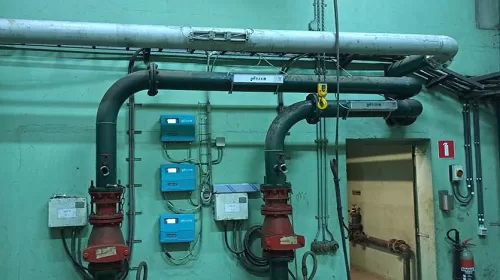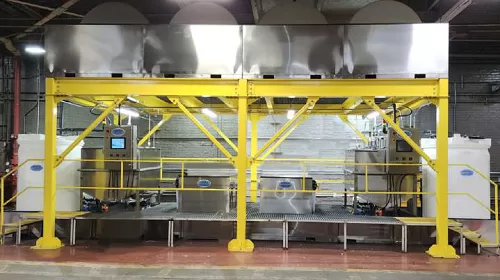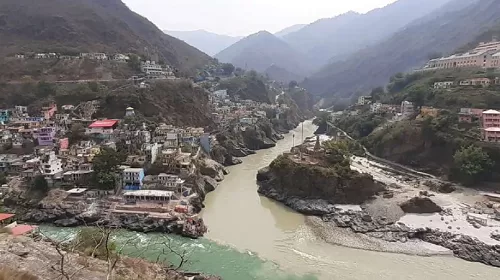KEEPING WATER FLOWING IN SÃO PAULO
Companhia de Saneamento Básico do Estado de São Paulo (SABESP) provides 28.4 million people with water and 25.2 million people with sewage collection daily. The organization also provides water and sewerage services to over 50% of the state’s municipalities. The largest water and wastewater management company in Latin America, SABESP seeks to provide its customers with unparalleled operational excellence through the latest technology and a focus on sustainability.
To meet these goals for its customers, SABESP created Integra 4.0, an initiative to innovate water and wastewater management along the Tietê River through digital advancements that simplify processes, increase collaboration between teams, and facilitate the use of emerging technologies such as big data and artificial intelligence, resulting in more agility, innovation, and precise decision-making. The program includes several projects, each set to meet growing demands in São Paulo while enhancing environmental stewardship. Together, they will improve the state’s infrastructure, foster sustainability, and enhance public services.
PRIORITIZING KEY LOCATIONS FOR LIFECHANGING RESULTS
Several projects that were part of Integra 4.0 stood out as innovative examples of how SABESP’s initiative will provide important resources to the community.
The Integra Tietê project, which began in 2023, will receive an estimated investment of BRL 15.3 billion by 2026. Its goal is to improve the quality of the Tietê River, which flows through the heart of São Paulo. SABESP was tasked with increasing the collection and treatment of wastewater from the watershed, implementing advanced hydraulic models and innovative operational systems developed with Bentley’s OpenFlows. This area encompasses 21 million inhabitants directly and indirectly. The team used OpenFlows Sewer to model Parque Novo Mundo wastewater system, so they can analyze the system, prepare for capacity expansion, and ultimately lower the risk of wastewater spills and impacts on the environment.
The Parque Novo Mundo wastewater system analysis project covered a population of over 3.18 million people in São Paulo’s metro area. The team used OpenFlows Sewer to digitally model 110 kilometers of pipes, identifying critical issues before expansion would take place.
Lastly, SABESP focused on Guarujá’s Vicente de Carvalho borough, a coastal area in São Paulo with a population of about 150,000 people. This region faces significant water supply challenges due to seasonal tourism spikes, irregular demand, and water scarcity during droughts. To address these issues, SABESP implemented OpenFlows WaterSight for real-time supply monitoring, seeking to improve pressure stability and provide better service to vulnerable areas.
CREATING DIGITAL TWINS FOR ENHANCED VISIBILITY
By using Bentley’s OpenFlows applications, SABESP was able to create digital twins of the targeted sites for modeling and analysis. The digital twins enabled the teams to make real-time decisions in a highly visual environment, streamlining decision-making among all stakeholders. This approach allowed the utility to address their infrastructure limitations and pinpoint where development will be necessary to provide the best service possible to their customers. Consequently, SABESP can now properly prioritize updates based on this data, ensuring proactive management. The teams to make real-time decisions in a highly visual environment, streamlining decision making among all stakeholders. This approach allowed the utility to address their infrastructure limitations and pinpoint where development will be necessary to provide the best service possible to their customers. Consequently, SABESP can now properly prioritize updates based on this data, ensuring proactive management.
From the start, SABESP used Bentley’s OpenFlows—to great success. “A challenge was the number of communities in Vicente de Carvalho,” said Diego Corte, SABESP’s engineer in the automation and operational efficiency department. “The water pressure in these areas was very low, and there were many complaints of water shortages. OpenFlows Water enabled us to analyze field data more easily and plan a more favorable and stable supply condition for these vulnerable areas.” On the Parque Novo Mundo project, SABESP’s Pedro Kayo Duarte Arashiro, hydraulics technologist, said, “OpenFlows Sewer was the best solution for analyzing the hydraulic behavior of the structures that make up the wastewater system, which has pipes of up to 4,500 millimeters in diameter, and the largest wastewater treatment plant in Latin America, with a capacity of 16 cubic meters per second. Its user-friendly graphical interface makes it easier to interpret the results, making the operations of such complex systems more secure.”
BRINGING THE RESULTS TO THE CUSTOMERS
Looking at individual project results, for the Sewer Operation 4.0 project, the team saw a 30% reduction in sewer overflows. They now have 90 maintenance hole-level sensors installed at strategic points along the network, transmitting signals remotely every five minutes to ensure real-time information gathering. “In addition to its operational advances and benefits, the Sewage Operation 4.0 Project has a direct and positive impact on the customer experience,” said Vilmar Meneses de Lima, engineer and division manager of sewer operation at SABESP. “With the sewage collection system operating more efficiently and reliably, SABESP offers greater security, providing quality services, guaranteeing sewage collection and treatment—and clean rivers and streams—driving a more positive customer experience, and promoting care for society and the environment.”
For the Parque Novo Mundo project, OpenFlows reduced work hours from 1,200 to just 120. Analysis prediction scenarios had errors of less than 2%, showing the team that rainwater contribution was one of the major problems affecting the wastewater system and that the pumping station needed to be assessed due to increase flows in 2026.
“Approximately 3.18 million people serviced by the Parque Novo Mundo wastewater treatment system will directly benefit, along with those living in the Tietê River Basin, which will benefit from reduced pollution,” said Arashiro. Meanwhile, for Guarujá’s Vicente de Carvalho, SABESP was able to improve water savings to 37,000 cubic meters per month. By leveraging OpenFlows applications, SABESP developed hydraulic models for their sewage and water supply systems. This enabled the creation of digital twins. Using real-time data for monitoring ensured integrated, accurate, and efficient management of water resources, as well as proactive maintenance of network infrastructure. Establishing an open, connected data environment has already resulted in a 30% reduction in overflows and backflows, ensuring pollution control of the Tietê River. Within a seven-month period, the digital twin saved approximately BRL 3.1 million in corrective maintenance, reduced corrective services by 30%, saved 2,800 hours of field work, and lowered carbon emissions.
Moving forward, SABESP plans to scale these solutions to other regions and systems under their jurisdiction. They plan to continue investing in technology, innovation, and strategic partnerships to meet long-term goals and create a more sustainable future for its customers and São Paulo.
PROJECT SUMMARY
- Organization: Companhia de Saneamento Básico do Estado de São Paulo – SABESP
- Solution: Water and Wastewater
- Location: São Paulo, Brazil
PROJECT OBJECTIVES
- To provide customers with unparalleled operational excellence through the latest technology.
- To meet growing demands in São Paulo while enhancing environmental stewardship.
Project Playbook: OpenFlows
FAST FACTS
- SABESP created Integra 4.0, the fourth phase of an initiative to innovate water and wastewater management along the Tietê River by using digital advancements.
- Four projects that were part of Integra 4.0 stood out as innovative examples of how SABESP’s initiative will provide important resources to the community.
- By using Bentley’s OpenFlows applications, SABESP was able to create digital twins of the sites that they sought to model and analyze.
ROI
- For the Sewer Operation 4.0 project, the team saw a 30% reduction in sewage overflows
- For the Parque Novo Mundo project, OpenFlows reduced work hours from 1,200 to just 120, with analysis prediction scenario errors at less than 2%.
- For Guarujá’s Vicente de Carvalho, SABESP was able to improve water savings to 37,000 cubic meters per month.
Callout Quote: “Bentley’s OpenFlows was used in SABESP’s Integra 4.0, facilitating modeling activities, both for design and maintenance. The tools let us anticipate any leaks and thus reduce water losses, cut costs, and increase the useful life of the assets used.”– José Hermínio da Silva Filho, Technical Services Division Manager, Companhia de Saneamento Básico do Estado de São Paulo – SABESP.
By Neda Simeonova, senior product marketing manager, water, at Bentley





